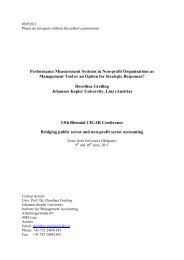A theoretical framework and classification of capability areas
A theoretical framework and classification of capability areas
A theoretical framework and classification of capability areas
You also want an ePaper? Increase the reach of your titles
YUMPU automatically turns print PDFs into web optimized ePapers that Google loves.
Table 1. An illustrative mapping to organisation management theories<br />
Capability <strong>areas</strong> for organisational performance <strong>and</strong> change: Capability <strong>areas</strong> for business process maturity (i.e. expected<br />
performance):<br />
7-S model [47] Burke-Litwin model [46] Main <strong>areas</strong> Sub <strong>areas</strong><br />
Systems Systems (policies <strong>and</strong> procedures)<br />
(1)<br />
Modelling • Business process design<br />
• Business process analysis<br />
Deployment • Business process implementation<br />
• Business process enactment<br />
• Business process measurement <strong>and</strong> control<br />
Optimisation • Business process evaluation<br />
• Business process improvement<br />
Strategy Mission <strong>and</strong> strategy Management • Strategy <strong>and</strong> KPIs<br />
External environment • External relationships <strong>and</strong> SLAs<br />
Skills Task <strong>and</strong> individual skills • Roles <strong>and</strong> responsibilities<br />
• Skills, expertise, training<br />
Management practices • Daily management<br />
Super-ordinate goals Organizational culture Culture • Values<br />
Staff (s<strong>of</strong>t aspects) Motivation • Attitudes <strong>and</strong> behaviours<br />
Work unit climate<br />
Individual needs <strong>and</strong> values<br />
Staff (hard aspects) Systems (2) • Appraisals <strong>and</strong> rewards<br />
Style Leadership • Top management commitment<br />
Structure Structure Structure • Organisation chart<br />
• Bodies<br />
The organisational performance <strong>and</strong> change theory <strong>of</strong> Waterman, Peters, <strong>and</strong> Philips [47] claim that<br />
the organisation’s ability to change depends on the organisation strategy, structure, systems (or<br />
Business processes), style, skills, staff, <strong>and</strong> ‘superordinate goals’ (or culture). Burke <strong>and</strong> Litwin [46]<br />
have formalised this claim in a causal model in which the external environment affects the<br />
organisational mission <strong>and</strong> strategy, leadership <strong>and</strong> culture. In turn, they affect the organisational<br />
structure, systems, management practices, individual tasks <strong>and</strong> skills, work unit climate, <strong>and</strong><br />
individual values. A combination <strong>of</strong> these factors will result in motivation, <strong>and</strong> performance.<br />
The relationship between business processes <strong>and</strong> business (process) excellence is further explained by<br />
theories on strategic management. Business processes are means to achieve strategic, tactical <strong>and</strong><br />
operational objectives [23]. For instance, Kaplan <strong>and</strong> Norton [49] present the strategy as a translation<br />
<strong>of</strong> the vision, which in turn is a translation <strong>of</strong> the core values <strong>and</strong> mission. Their balanced scorecard<br />
(BSC) systematically derives KPIs regarding four perspectives: (1) the financial situation, (2) the<br />
customers, (3) the internal business processes, <strong>and</strong> (4) learning <strong>and</strong> growth. Variants <strong>of</strong> the BSC exist,<br />
which add other stakeholders [59,60]. For instance, the business motivation model <strong>of</strong> OMG [60]<br />
distinguishes: (1) the ends (i.e. vision, <strong>and</strong> KPIs), (2) the means (i.e. mission, strategic <strong>and</strong> tactic<br />
activities, business rules <strong>and</strong> policies), (3) the influencers (i.e. internal, such as values, or external,<br />
such as stakeholders or regulation), <strong>and</strong> (4) their assessment (e.g. a SWOT analysis). With regard to<br />
the main <strong>capability</strong> <strong>areas</strong>, the translation <strong>of</strong> the organisational strategy into the strategy <strong>of</strong> a specific

















